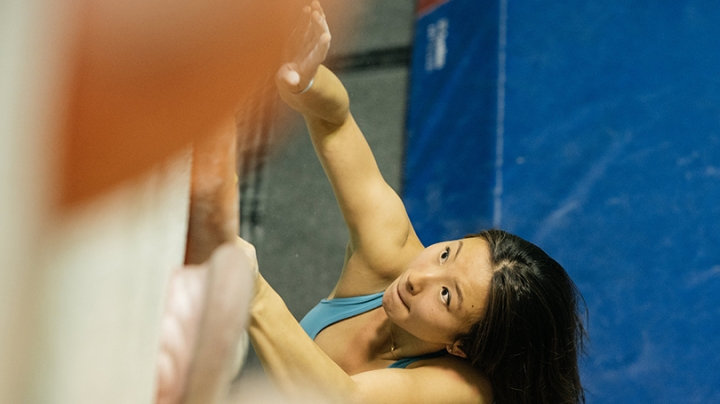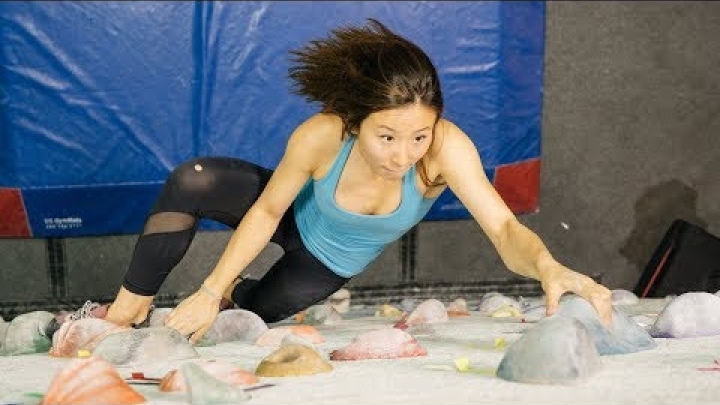During recess time at her elementary school in Potomac, Maryland, Kayla Lieuw ’19 was a monkey bars expert. So her mother took her to a climbing gym, where the young student upped her game.
“I just loved it,” Lieuw recalls. “I wanted to sign up for the youth climbing team that day.”
She did sign up, and kept at it. By the time she reached high school, Lieuw was training as much as six days a week, four hours a day, specializing in indoor speed climbing—scaling walls using strategically placed handholds and footholds, as fast as possible. She won four youth national climbing competitions and, in 2013, brought home a silver medal from the world youth championships in Canada.
Soon after arriving at Dartmouth two years ago, Lieuw and fellow climber Matthew Rube ’19, whom she had met during high school competitions, started the College’s first indoor climbing team. A sub-group of the Dartmouth Mountaineering Club, they compete at college climbing gyms around the country. “It’s great to train with other people, and really helpful to share tips,” Lieuw says. “I’m hearing from a lot of incoming students who want to join the team, and I’m hoping we’ll get more women on it.”
At the Daniels Climbing Gym in the basement of Maxwell Hall, Lieuw, Rube, and two other team members recently cranked up Simon and Garfunkel’s Baby Driver and started climbing the walls.
“Before you even touch the wall, you spend a few minutes planning, deciding where you will put your hands and feet, what your exact body movements will be, and what muscles you’ll use—or not use. You really have to focus,” says Rube.
There are three kinds of events in indoor climbing competitions: bouldering, sport climbing, and speed climbing. “In high-level bouldering, the handholds and footholds are set up differently on the wall for each of five climbs, and the competitor can’t see them in advance, or talk with anyone who did them,” Rube explains. “You have a four- or five-minute limit, and you get as far up as you can.” Competitors get a point for reaching each hold, and more points for making it to the top.
Sport climbing is done on taller walls, with ropes. Speed climbers, as the name suggests, excel at rapid ascent. During its first season, Dartmouth’s team, which ranges from 10-15 members, came in 17th out of about 30 teams on the national collegiate circuit. Last year, they rose to ninth.
The team trains indoors, but members can occasionally be seen, Spiderman-like, scaling campus buildings, always with permission from the Department of Safety and Security. “We can go up Bartlett, Rollins, and a few others,” Rube says. “We’re also close to some of the best mountain climbing in the country, so people do that with the same passion for defying gravity.” Indoor bouldering, he says, is more “organized and regimented” than the outdoor sport.
At the gym, Rube watches team member Nicolas Flores ’19 make his way up a wall, trying to avoid slipping. He falls a few times onto the generously padded floor, but always jumps back up with a grin.
“I’m still learning,” Flores says. “The hardest part for me is the strain on my fingers, holding up my entire body weight. At first you have to cope with some fear. But eventually you figure out that if you fall correctly, on your back on the pad, it’s no big deal.”
Flores much prefers climbing to other fitness regimes. “Lifting weights or running on a treadmill can be boring, and it’s not very social.” he says. “But this is very social. And it’s never boring because each climb is different from the last.”
Team member Michael Everett ’19 likes bouldering because it marries muscles to mind. “It’s intellectual, but not academic,” he says. Yet he sees a connection between climbing and his academic pursuits. An anthropology major, Everett is so interested in the way climbers use their hands and feet that he has begun studying the phalanges (what we would call our fingers and toes) on fossilized remains of early humans. He’ll do field work on his second trip to South Africa this winter with Jeremy DeSilva, associate professor of anthropology, and Nathaniel Dominy, the Charles Hansen Professor of Anthropology.
“We’ll go into vertical caves to recover baboon bones, and we’ll try to learn how climbing that shaft might have affected the curvature of their phalanges,” Everett says.
Human bodies, he notes, have evolved in ways that make climbing more difficult than it was for baboons. Unlike simian ancestors, we don’t have tails or grasping thumbs on our feet, and our arms have shortened over eons. But Everett says the human hand and brain are well designed for climbing, and he enjoys it so much that the gym in Maxwell has become his “second home.”
See the climbing team in action:

